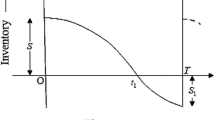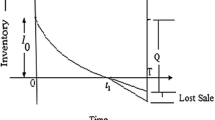Abstract
Customer purchasing needs are generally affected by factors such as selling price and inventory level and not only by demand. Demand is considered either to be a constant or a function of a single variable in most of the cases, which is not always feasible. Consequently, in the present study, demand rate as a function of stock level and selling price. The deterioration rate has been considered here to be Weibull two parameters, shortages are partially backlogged. The major objective is to determine the optimal selling price, the optimal replenishment schedule and the optimal order quantity simultaneously such that, the total profit is maximized. In this model, first show that for any given selling price, optimal replenishment schedule exists and unique. Then, the total profit is a concave function of price with respect to time. Next, present a simple algorithm to find the optimal solution. Finally, in this paper solve a numerical example to illustrate the solution procedure and the algorithm.




Similar content being viewed by others
References
Baker, R.C., Urban, T.L.: A deterministic inventory system with an inventory-level-dependent demand rate. J. Oper. Res. Soc. 39, 823–831 (1988)
Chang, C.T., Teng, J.T., Goyal, S.K.: Optimal replenishment policies for non-instantaneous deteriorating items with stock-dependent demand. Int. J. Prod. Econ. 123, 62–68 (2010)
Choudhury, D.K., Karmakar, B., Das, M., Datta, T.K.: An inventory model for deteriorating items with stock-dependent demand, time-varying holding cost and shortages. OPSEARCH (2013). doi:10.1007/s12597-013-0166-x
Chowdhury, R.R., Ghosh, S.K., Chaudhuri, K.S.: An inventory model for deteriorating items with stock and price sensitive demand. Int. J. Appl. Comput.l Math. 1(2), 187–201 (2015)
Covert, R.P., Philip, G.C.: An EOQ model for items with Weibull distribution deterioration. AIIE Trans. 5(4), 323–326 (1973)
Geetha, K.V., Udayakumar, R.: Optimal lot sizing policy for non-instantaneous deteriorating items with price and advertisement dependent demand under partial backlogging. Int. J. Appl. Comput. Math. 2(2), 171–193 (2016)
Giri, B.C., Pal, S., Goswami, A., Chaudhuri, K.S.: An inventory model for deteriorating items with stock-dependent demand rate. Eur. J. Oper. Res. 95, 604–610 (1996)
Goh, M.: EOQ models with journal demand and holding cost functions. Eur. J. Oper. Res. 73, 50–54 (1994)
Gupta, R., Vrat, P.: Inventory model with multi-items under constraint systems for stock dependent consumption rate. Oper. Res. 24, 41–42 (1986)
Gupta, K.K., Sharma, A., Singh, P.R., Malik, A.K.: Optimal ordering policy for stock-dependent demand inventory model with non-instantaneous deteriorating items. Int. J. Soft Comput. Eng. 3(1), 279–280 (2013)
Jaggi, C.K., Tiwari, S., Goel, S.K.: Credit financing in economic ordering policies for non-instantaneous deteriorating items with price dependent demand and two storage facilities. Ann. Oper. Res. (2016). doi:10.1007/s10479-016-2179-3
Konstantaras, I., Skouri, K.: A note on a production-inventory model under stock-dependent demand, Weibull distribution deterioration, and shortage. Int. Trans. Oper. Res. 18(4), 527–531 (2011)
Lee, W.C., Wu, J.-W.: An EOQ model for items with Weibull distributed deterioration, shortages and power demand pattern. Int. J. Inf. Manag. 13(2), 19–34 (2002)
Maihami, R., Kamalabadi, I.N.: Pricing and inventory control for non-instantaneous deteriorating items with partial backlogging and time and price dependent demand. Int. J. Prod. Econ. 136, 116–122 (2012)
Mandal, B.N., Phaujdar, S.: An inventory model for deteriorating items and stock-dependent consumption rate. J. Oper. Res. Soc. 40, 483–488 (1989)
Mishra, U.: A waiting time deterministic inventory model for perishable items in stock and time dependent demand. Int. J. Syst. Assur. Eng. Manag. (2015a). doi:10.1007/s13198-015-0404-0
Mishra, U.: An EOQ model with time dependent Weibull deterioration, quadratic demand and partial backlogging. International J. Appl. Comput. Math. (2015b). doi:10.1007/s40819-015-0077-z
Mishra, V.K.: An inventory model of instantaneous deteriorating items with controllable deterioration rate for time dependent demand and holding cost. J. Ind. Eng. Manag. 6(2), 495–506 (2013)
Mishra, U., Tripathy, C.K.: An inventory model for time dependent Weibull deterioration with partial backlogging. Am. J. Oper. Res. 2(2), 11–15 (2012)
Mishra, U., Tripathy, C.K.: An inventory model for Weibull deteriorating items with salvage value. Int. J. Logist. Syst. Manag. 22(1), 67–76 (2015)
Pal, S., Goswami, A., Chaudhuri, K.S.: A deterministic inventory model for deteriorating items with stock-dependent demand rate. Int. J. Prod. Econ. 32, 291–299 (1993)
Pal, S., Mahapatra, G.S., Samanta, G.P.: An inventory model of price and stock dependent demand rate with deterioration under inflation and delay in payment. Int. J. Syst. Assur. Eng. Manag. 5(4), 591–601 (2014)
Panda, S., Saha, S., Basu, M.: An EOQ model for perishable products with discounted selling price and stock dependent demand. CEJOR 17, 31–53 (2009)
Ray, J., Goswami, A., Chaudhuri, K.S.: On an inventory model with two levels of storage and stock-dependent demand rate. Int. J. Syst. Sci. 29, 249–254 (1998)
Roy, A.: An inventory model for deteriorating items with price dependent demand and time-varying holding cost. AMO-Adv. Model. Optim. 10(2008), 25–36 (2008)
Roy, T., Chaudhuri, K.S.: A production-inventory model under stock-dependent demand, Weibull distribution deterioration and shortage. Int. Trans. Oper. Res. 16(3), 325–346 (2009)
Soni, H., Shah, N.H.: Optimal ordering policy for stock dependent demand under progressive payment scheme. Eur. J. Oper. Res. 184, 91–10 (2008)
Soni, H.N.: Optimal replenishment policies for non-instantaneous deteriorating items with price and stock sensitive demand under permissible delay in payment. Int. J. Prod. Econ. 146, 259–268 (2013)
Uthayakumar, R., Parvathi, P.: A deterministic inventory model for deteriorating items with partially backlogged and stock and time dependent demand under trade credit. Int. J. Soft Comput. 1(3), 199–206 (2006)
Weiss, H.J.: Economic Order Quantity models with nonlinear holding cost. Eur. J. Oper. Res. 9, 56–60 (1982)
Wu, J.W., Lin, C., Tan, B., Lee, W.-C.: An EOQ inventory model with time-varying demand and Weibull deterioration with shortages. Int. J. Syst. Sci. 31(6), 677–683 (2000)
Wu, K.S., Ouyang, L.Y., Yang, C.T.: An optimal replenishment policy for non-instantaneous deteriorating items with stock-dependent demand & partial backlogging. Int. J. Prod. Econ. 101, 369–384 (2006)
You, S.P.: Inventory policy for products with price and time-dependent demands. J. Oper. Res. Soc. 56, 870–873 (2005)
Acknowledgments
The author would like to express his gratitude to the editors and anonymous referees for their constructive suggestions to enhance the clarity of the present article.
Author information
Authors and Affiliations
Corresponding author
Rights and permissions
About this article
Cite this article
Mishra, U. An Inventory Model for Weibull Deterioration with Stock and Price Dependent Demand. Int. J. Appl. Comput. Math 3, 1951–1967 (2017). https://doi.org/10.1007/s40819-016-0217-0
Published:
Issue Date:
DOI: https://doi.org/10.1007/s40819-016-0217-0




